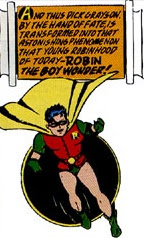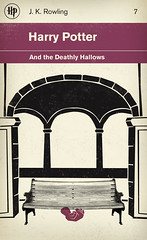 Occasionally I've mentioned the LiveJournal group scans_daily as one of my sources of comic-book background knowledge, commentary, and unusual images.
Occasionally I've mentioned the LiveJournal group scans_daily as one of my sources of comic-book background knowledge, commentary, and unusual images.
That's no longer available. Last weekend LiveJournal suspended the group due to copyright complaints. This was big news in the comics-discussion community, with reports on the major news websites and various creators being quizzed about their opinions. Brigid Alvorsen provided a good overview of the situation and people's reactions.
The discussion largely boils down to two positions. On one side, scans_daily's defenders argue that it was an enthusiastic fan community, sharing samples of work members liked and disliked. The law allows folks to reproduce a limited amount of copyrighted material in the context of critical commentary.
 What's more, those fans argue, comics creators and publishers should welcome such sharing because it publicizes new products. (This is, of course, the same argument people have made about sharing music without payment to its creators.)
What's more, those fans argue, comics creators and publishers should welcome such sharing because it publicizes new products. (This is, of course, the same argument people have made about sharing music without payment to its creators.)
The opposing view is that people on scans_daily were using "fair use" and anonymity as a mask for widespread copyright violations. Every Wednesday members uploaded pages and pages of the latest comics, revealing major twists in storylines. The group's guidelines about not scanning too much of any one magazine didn't keep large chunks from appearing, and entire stories from the "Golden Age."
And as for such a community's effect on the market, this view holds, the free availability of that material ultimately makes people less likely to buy it. One of the most vehement voices from this side was Kevin Church at Beaucoup Kevin.
But by the time that debate took place, scans_daily was shut down, its members scattered like refugees from Gotham at the start of the "No Man's Land" arc.
 So was scans_daily a large-scale copyright violation, cheating comics copyright-holders? Or was it a community for perceptive, funny, and impassioned discussion of comic books? In my experience, it was both.
So was scans_daily a large-scale copyright violation, cheating comics copyright-holders? Or was it a community for perceptive, funny, and impassioned discussion of comic books? In my experience, it was both.
 When I started looking into American comics again, after a gap of twenty years, scans_daily was one of the most helpful resources I found. It offered glimpses of both the latest developments and stories long out of print. About half the panels illustrating my weekly Robin posts are extracted from scans_daily scans. I learned to spot the icons of knowledgeable Robin fans and follow their postings. (Otherwise, I'd never have been able to use that "No Man's Land" metaphor.)
When I started looking into American comics again, after a gap of twenty years, scans_daily was one of the most helpful resources I found. It offered glimpses of both the latest developments and stories long out of print. About half the panels illustrating my weekly Robin posts are extracted from scans_daily scans. I learned to spot the icons of knowledgeable Robin fans and follow their postings. (Otherwise, I'd never have been able to use that "No Man's Land" metaphor.)
Furthermore, I bought comics because of what I saw on scans_daily, comics both new (such as Nightwing: Freefall and The Brave and the Bold, #15, which makes the case that Dick Grayson is the most trusted man in the DC Universe) and secondhand (Robin, #10; Impulse, #50; Superboy, #85; etc.). As soon as a member posted panels from Mouse Guard, I put in a request to my library.
At the same time, I was troubled by how often scans_daily postings included many pages from new magazines, frequently with no credits for the writers or artists. As for the critical commentary that excuses reproductions, some members did indeed offer insights on character development, graphic techniques, or creators' careers. There were lots of jokes. But too many of the remarks were of the order of "I hate Dan DiDio cuz he hates Blue Beetle," which makes no sense and hardly justifies scanning half of the latest Blue Beetle magazine.
 Given that situation, I agree with the many observers who've said it was only a matter of time before scans_daily got shut down. The copyright doctrine of "fair use" is misty, but many postings were clearly beyond its bounds, and big web services like LiveJournal are antsy.
Given that situation, I agree with the many observers who've said it was only a matter of time before scans_daily got shut down. The copyright doctrine of "fair use" is misty, but many postings were clearly beyond its bounds, and big web services like LiveJournal are antsy.
Some folks blamed comics scripter Peter David for complaining about one post, but he and Marvel Comics were perfectly within their rights to do so. Furthermore, just as my comics research made me appreciate scans_daily, so I'm grateful to David. His Young Justice of a decade ago offered a fun take on Tim Drake as Robin, and his book on comics scripting is a fine how-to guide.
The scans_daily shutdown has produced some interesting commentary. Leigh Walton at Picture Poetry raised the issue of gender:
A friend...grumbled today about the dismissive attitude of certain commenters (”oh well, it was full of bitching and slash anyway”), declaring that reaction to be part of a broader discomfort that many male fans have with the feminine form of fandom. In response, she more or less said “a man in S_D feels like a woman in a comic shop.” . . .
I remember being pretty shocked at the culture of S_D when I first discovered it years ago. It was a thriving community of fans interacting with superhero comics in an entirely different manner than I was used to. But it didn’t feel like “this is how they do it on the internet,” it felt like “this is how they do it when women are in charge.”
Which was the first time I realized that (a) scans_daily had women in charge, or (b) there's such a deep split within comics fandom. Lisa Fortuner at Robot 6
added more remarks while drawing a line between reasons for the shutdown itself and reasons for different fans' responses to it.

Another interesting reaction came from comics scripter
Gail Simone, who herself came out of the female fan ranks:
I sympathize with any creators who felt their work was spoiled. I JUST this week had the ending of my latest issue of Wonder Woman spoiled.
Simone laments some comics-sharing on
artistic rather than commercial grounds, because it can interfere with readers' enjoyment. I find that attitude very interesting. Even so, Simone makes clear, she's ready to live with spoilers in such communities as scans_daily if they're a reflection of reader enthusiasm.
Everybody acknowledges that LiveJournal's shutdown has simply pushed the same behavior elsewhere. Now there's a
noscans_daily on LiveJournal for former members to keep up the conversation, and a reconstituted
scans_daily on another service. (I haven't joined because I'm too busy right now to sign up for anything that includes the word "insane." It would be redundant.) And of course the internet contains torrents of files reproducing nearly every comic book ever published, hidden deeper than scans_daily was and thus not available to new fans.
Meanwhile, the comic-book publishers still face shrinking magazine sales, and the pitfalls and potential of new digital formats. How do they please established readers and cultivate new ones? Keep characters fresh yet familiar? Price material economically but profitably? No one knows which challenge to attack first. But scans_daily had its head up.






 The panels above come from the first page of the first issue of
The panels above come from the first page of the first issue of 




 The
The 








 Occasionally I've mentioned the LiveJournal group scans_daily as one of my sources of comic-book background knowledge, commentary, and unusual images.
Occasionally I've mentioned the LiveJournal group scans_daily as one of my sources of comic-book background knowledge, commentary, and unusual images. What's more, those fans argue, comics creators and publishers should welcome such sharing because it publicizes new products. (This is, of course, the same argument people have made about sharing music without payment to its creators.)
What's more, those fans argue, comics creators and publishers should welcome such sharing because it publicizes new products. (This is, of course, the same argument people have made about sharing music without payment to its creators.) So was scans_daily a large-scale copyright violation, cheating comics copyright-holders? Or was it a community for perceptive, funny, and impassioned discussion of comic books? In my experience, it was both.
So was scans_daily a large-scale copyright violation, cheating comics copyright-holders? Or was it a community for perceptive, funny, and impassioned discussion of comic books? In my experience, it was both. When I started looking into American comics again, after a gap of twenty years, scans_daily was one of the most helpful resources I found. It offered glimpses of both the latest developments and stories long out of print. About half the panels illustrating my
When I started looking into American comics again, after a gap of twenty years, scans_daily was one of the most helpful resources I found. It offered glimpses of both the latest developments and stories long out of print. About half the panels illustrating my  Given that situation, I agree with the many observers who've said it was only a matter of time before scans_daily got shut down. The copyright doctrine of "fair use" is misty, but many postings were clearly beyond its bounds, and big web services like LiveJournal are antsy.
Given that situation, I agree with the many observers who've said it was only a matter of time before scans_daily got shut down. The copyright doctrine of "fair use" is misty, but many postings were clearly beyond its bounds, and big web services like LiveJournal are antsy.




